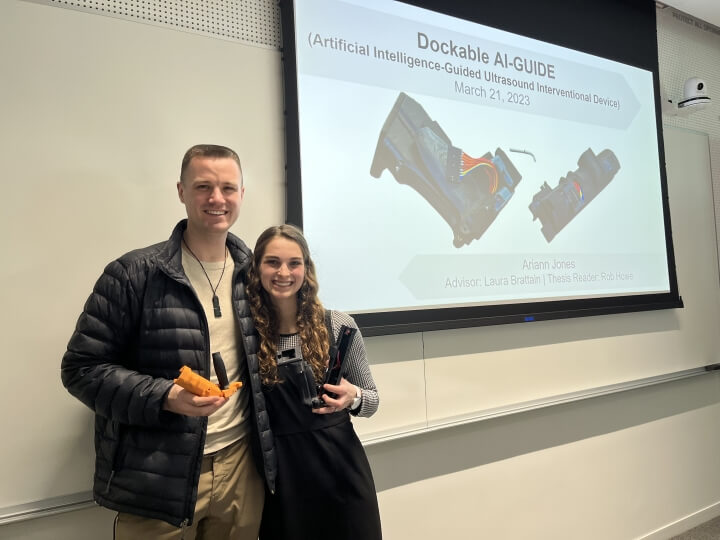For a senior capstone project, Ariann Jones, right, devised an easy-to-assemble redesign for a medical device that stops blood hemorrhages in the femoral region of the body.
Engineering Design Projects (ES 100), the capstone course at the Harvard John A. Paulson School of Engineering and Applied Sciences (SEAS), challenges seniors to engineer a creative solution to a real-world problem.
Dockable AI-GUIDE
Ariann Jones, S.B. ‘23, Bioengineering
Advisor: Laura Brattain
Please give a brief summary of your project.
AI-GUIDE (Artificial Intelligence-Guided Ultrasound Interventional Device) is a prototype of a medical device made by MIT Lincoln Lab that stops blood hemorrhages in the femoral region of the body by robotically inserting a needle into appropriate vasculature identified by the combination of imagery from the ultrasound (US) probe and algorithms from the AI. However, the prototype had a very fragile joint that caused the device to break into two pieces when dropped. For my project, I redesigned AI-GUIDE into a dockable device that allows the device to be transported as two pieces and assembled rapidly through sliding and locking features without sacrificing the accuracy of the device.
How did you come up with this idea for your final project?
A family member works for the US Army Institute of Surgical Research, a group that collaborates with Lincoln Lab on certain projects. He was working with Lincoln Lab on the nerve block application of AI-GUIDE, and he put me in touch with the mechanical engineers focusing on design optimization.
Is there a real-world challenge that this project addresses?
Existing devices that stop blood hemorrhages in non-compressible regions of the body, meaning regions that cannot suppress bleeding through tourniquets or direct pressure, are not all robotic, dependent on US imagery, free-standing, or specific to the pelvic region of the body. AI-GUIDE is a device that combines all of these features to treat blood hemorrhages in prehospital settings to ensure that patients can make it to the hospital alive for surgical treatment, given that 90 percent of blood hemorrhage deaths occur before the wounded make it to the hospital.
What was the timeline of your project?
I spent the first 1.5 months defining the project and understanding the scope of the problem. I spent the next 2.5 months designing and prototyping different ideas to make the mechanical joint rapidly connect and disconnect. Then, two more months were spent on building the final design of AI-GUIDE; this involved 3D printing several iterations of the final design idea and machining a customized lock for securing the joint in place. Finally, I spent two weeks testing the device and two weeks analyzing the data.
What part of the project proved the most challenging?
Understanding the scope of the project was the most challenging part. I looked to the world around me for inspiration on how to join two pieces, such as door hinges, the connection between a laptop keypad and screen, slipping a whisk onto a beater, snapping two Tupperware pieces together, Legos, etc. Once I realized that I could generate ideas through the world around me, it became much easier.
What part of the project did you enjoy the most?
I enjoyed the prototyping phase the most. I 3D printed multiple different ideas, then compared them to determine which pieces made for the quickest assembly and disassembly. With each design that I tried, I analyzed its shortcomings, created solutions, and tried a new approach. The iterative stages of the design process really intrigued me, and I found it rewarding to meticulously assess the system and optimize the design for each version.
What did you learn, or skills did you gain, through this project?
I learned all about the anatomy and vasculature of the femoral region of the body as well as other medical applications to AI-GUIDE. AI-GUIDE can be used to perform nerve block, a medical procedure superior to anesthesia in that it reduces recovery time, and tracheostomy, an operation intended to open up the airway for enhanced breathing. I also learned to use tools such as a lathe to turn down the diameter of the shaft that I selected, and programs such as Solid Works to sketch out different components.
Press Contact
Matt Goisman | mgoisman@g.harvard.edu
